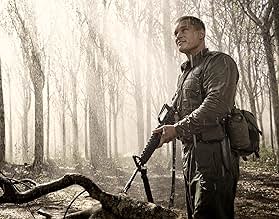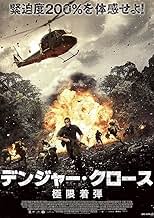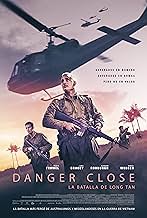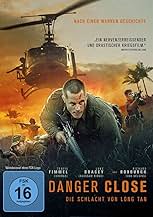In August 1966, in a Vietnamese rubber plantation called Long Tan, 108 young and inexperienced Australian and New Zealand soldiers are fighting for their lives against 2500 North Vietnamese ... Read allIn August 1966, in a Vietnamese rubber plantation called Long Tan, 108 young and inexperienced Australian and New Zealand soldiers are fighting for their lives against 2500 North Vietnamese and Viet Cong soldiers.In August 1966, in a Vietnamese rubber plantation called Long Tan, 108 young and inexperienced Australian and New Zealand soldiers are fighting for their lives against 2500 North Vietnamese and Viet Cong soldiers.
- Awards
- 8 wins & 6 nominations total
Rihari Te Are
- Gunner Murry Watene
- (as Richard Te Are)
Featured reviews
There's not much wrong with this film, but don't get taken in by the hyperbole in a lot of the reviews here. It certainly isn't a 10/10, and it isn't the greatest war film ever made - it's not even close to that. It's a solid, watchable film, about a real event that means a lot to Australian and Kiwi forces.
There's some decent action sequences, although I'd credit the Vietcong with slightly better tactics than simply running blindly towards automatic weapons, which seems to be the default for most of the film. You can also have fun ticking off the war film cliches - likeable character talking about what he's going to do when all this is over - check, man in desperate situation calling in fire support on his own position - check.
If you want an independent film that might actually be one of the greatest war films ever made, I'd strongly recommend Kajaki - this really isn't in the same league, good though it is.
There's some decent action sequences, although I'd credit the Vietcong with slightly better tactics than simply running blindly towards automatic weapons, which seems to be the default for most of the film. You can also have fun ticking off the war film cliches - likeable character talking about what he's going to do when all this is over - check, man in desperate situation calling in fire support on his own position - check.
If you want an independent film that might actually be one of the greatest war films ever made, I'd strongly recommend Kajaki - this really isn't in the same league, good though it is.
Up front I love history and know this story quite well. So for me I felt I was flicking in and out of a documentary verses a movie. Normally this is ideal for me but while still impressed I felt it stopped short of all time great.
I will be watching again mainly to figure out what was missing but still a great film for anyone who loves reasonably accurate and terrifying historical situations. The battle scenes were incredible and the linking of the NZ artillery was exceptional.
I don't view historical films as a statement on the rights and wrongs of the time so it felt real to me from the perspective from which it was told.
I will be watching again mainly to figure out what was missing but still a great film for anyone who loves reasonably accurate and terrifying historical situations. The battle scenes were incredible and the linking of the NZ artillery was exceptional.
I don't view historical films as a statement on the rights and wrongs of the time so it felt real to me from the perspective from which it was told.
As movies about real battles go, this one holds its own.
If I have a criticism it would be what director Kriv Stenders himself was worried about when he showed the film to the real Harry Smith and veterans of the battle. Stenders was concerned "... that a cinematic interpretation of the film, overdramatizing some moments and fictionalizing others, would be an issue with veterans of the battle".
Although Harry Smith told Stenders he thought the film was great, I feel those scenes, especially the exchanges between Major Smith (Travis Fimmel) and Private Large (Daniel Webber), the stereotypical "Hollywood" stuff, do sound a false note. However, the film is a technical triumph with a superb score and, for the most part, seems honest to events.
The film is similar to Mel Gibson's "We Were Soldiers": the unexpected enemy force; the cut-off platoon; helicopter pilots defying orders to provide aid and impressive firepower that doesn't overshadow the discipline and guts of the troops on the ground. Both were straightforward battles without civilians caught in the crossfire.
As an Australian, I'm not sure how non-Australian audiences will view "Danger Close". The accents could be challenging and the look of the Australians and New Zealanders is noticeably different to the helmeted U.S. Army and Marines familiar from documentaries and newsreels. Ever since the war, the respective tactics of the allies have been dissected in books and back-and-forth sessions on military history blogs. The Diggers of that era actually looked like the U.S. Army LRRPs or even the VC; styled for jungle warfare.
Another thought, a great victory is only in proportion to the toughness of the enemy. All accounts I've read also acknowledge the bravery of the Vietnamese. You do see it in the film, but it could have been stated.
Despite the rights and wrongs of Australia's involvement, Long Tan has emerged as one of our most iconic battles. Maybe it's partly guilt over the way Vietnam veterans were neglected for so long. Maybe it's also because not much was expected of the "Baby Boomers", but they stood up nonetheless.
Like Peter Weir's "Gallipoli", "Danger Close" will probably be how future generations will know this battle. With that in mind, the filmmakers and the stars, despite the odd flaw, have left us with a powerful and affecting experience.
If I have a criticism it would be what director Kriv Stenders himself was worried about when he showed the film to the real Harry Smith and veterans of the battle. Stenders was concerned "... that a cinematic interpretation of the film, overdramatizing some moments and fictionalizing others, would be an issue with veterans of the battle".
Although Harry Smith told Stenders he thought the film was great, I feel those scenes, especially the exchanges between Major Smith (Travis Fimmel) and Private Large (Daniel Webber), the stereotypical "Hollywood" stuff, do sound a false note. However, the film is a technical triumph with a superb score and, for the most part, seems honest to events.
The film is similar to Mel Gibson's "We Were Soldiers": the unexpected enemy force; the cut-off platoon; helicopter pilots defying orders to provide aid and impressive firepower that doesn't overshadow the discipline and guts of the troops on the ground. Both were straightforward battles without civilians caught in the crossfire.
As an Australian, I'm not sure how non-Australian audiences will view "Danger Close". The accents could be challenging and the look of the Australians and New Zealanders is noticeably different to the helmeted U.S. Army and Marines familiar from documentaries and newsreels. Ever since the war, the respective tactics of the allies have been dissected in books and back-and-forth sessions on military history blogs. The Diggers of that era actually looked like the U.S. Army LRRPs or even the VC; styled for jungle warfare.
Another thought, a great victory is only in proportion to the toughness of the enemy. All accounts I've read also acknowledge the bravery of the Vietnamese. You do see it in the film, but it could have been stated.
Despite the rights and wrongs of Australia's involvement, Long Tan has emerged as one of our most iconic battles. Maybe it's partly guilt over the way Vietnam veterans were neglected for so long. Maybe it's also because not much was expected of the "Baby Boomers", but they stood up nonetheless.
Like Peter Weir's "Gallipoli", "Danger Close" will probably be how future generations will know this battle. With that in mind, the filmmakers and the stars, despite the odd flaw, have left us with a powerful and affecting experience.
Went to the first public screening at the Sydney Film Festival tonight with members of my family and sat in the front row in a packed cinema. Director Kriv Stenders has taken a big undertaking in telling this highly recognised Australian and New Zealand battle of the Vietnam War that has however been long overdue in getting a major screen treatment. He has succeeded brilliantly. The film's relentless action and attention to detail are mixed in with moving scenes of young conscripts and volunteer soldiers grappling to stay alive in order to return to their loved ones at home. Much like Peter Weir's Gallipoli the mateship ethos shines in this movie. However, unlike that film, most of Danger Close concentrates on the battle itself, and what a technically amazing film it is in presenting and creating a visceral and tense atmosphere for the audience.The performances are excellent all round but particular mention must go to Daniel Webber as Private Paul Large, his moving portrayal of a young conscript struggling and battling courageously to help his mates and himself survive, while looking forward to returning home to his fiance and family is brilliant. As noted earlier the action in this film is relentless, from start to finish, however it never ignores the humanity and futility of war through the loss of life of many young soldiers. The roll call of ANZAC soldiers who died in the battle, noted at the end of the film with their ages, makes that abundantly clear. HIGHLY RECOMMENDED.
The movie took a little while to get to the action, making the beginning a little boring; they also didn't add in any background story to the main characters in the film, which down graded it a little more. But Once the movie picked up and you got to the battle scenes it turned into a good war film. It was very intriguing to know that this was based off of a true event that happened. Knowing that it was true made it worth while to watch. The filming was great and the actors were extremely believable. The war scenes were greatly filmed and action packed as the explosions and gun fire looked extremely real. It's defiantly worth a watch if you like war movies.
Did you know
- TriviaThe term, "Roger that", is an Americanism, originally from CB radio culture, and often used in military movies. However, it would never be said (or permitted, by any NCO or Officer within earshot) in the Australian Army. "Roger" is the only accepted proword. Similarly, the phrase, "I repeat", when repeating some for clarity over the radio telephone (RATEL), is not permitted. Instead the operator would use, "I say again...". This is because "repeat" is a proword used when directing artillery or naval fire (e.g "request for the same volume of fire to be fired again with or without corrections or changes")
- GoofsThe entire battle took place in a torrential tropical downpour from start to finish. Evidently, this would be hard to film for dramatic purposes. The airstrike never happened not because of a dud smoke grenade, but the cloud was so low and rain so intense the pilots could not identity the target area.
- Quotes
Major Harry Smith: There's a thousand ways to die in a war zone.
- Crazy creditsPart way through the final credits, after showing the actors and pictures of their real life counterparts and some of the principal credits, acknowledgment of the 6RAR's Presidential Unit Citation from the USA made in 1968 but that Australia took 45 years to acknowledge the soldiers who fought in a similar way.
This is followed by an Honour Roll of the Australian Soldiers killed during this battle.
- ConnectionsFeatured in Danger Close: Behind the Scenes (2019)
- How long is Danger Close?Powered by Alexa
Details
- Release date
- Country of origin
- Official sites
- Languages
- Also known as
- Danger close
- Filming locations
- Production companies
- See more company credits at IMDbPro
Box office
- Budget
- A$24,000,000 (estimated)
- Gross worldwide
- $2,092,198
- Runtime
- 1h 58m(118 min)
- Color
- Aspect ratio
- 2.35 : 1
Contribute to this page
Suggest an edit or add missing content










































